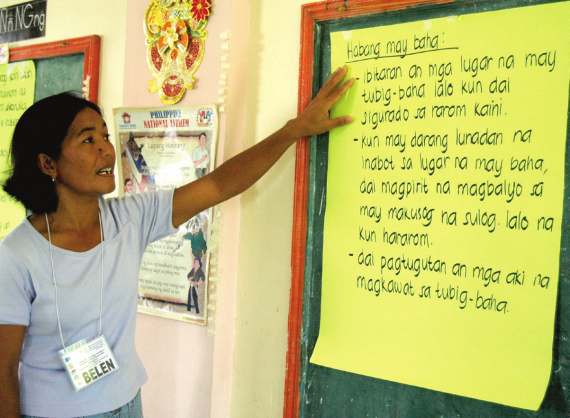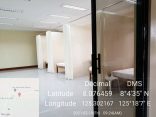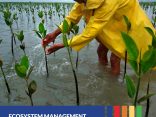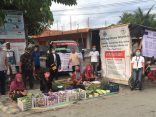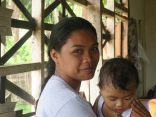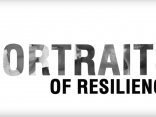During the handover activities of the ASCEND Project, stories were plentiful of important lessons learnt, and of changes of great consequence.
Talk about the end of the project, about exit strategies and responsible handover started as early as the inception phase of ASCEND. Still, the actual closure, after five years of working together, brought a mixture of emotions that made not a few teary-eyed.
Like most other ending projects, this one question needs to be asked: “what has the three phases of ACCORD contributed to improving the lives of vulnerable households in high-risk communities?”
Kagawad Belen of San Bernardino in Calabanga has a straightforward answer to the question: that her experience with ACCORD has changed her to a stronger and more knowledgeable person who is committed to help her village reduce the negative effects of destructive floods that frequently affects them.
Kagawad Belen explains that the learning activities, in particular the assessment sessions, were important activities that helped her become what she is now. She recalls that the assessments conducted after each training she participated in as a community facilitator have helped her improve her knowledge and skills as a community facilitator or CF. With each activity planning she participates in, she becomes more knowledgeable, and more skilled, and more involved.
She reflects that a growing number of community members have developed the capacity to for planning, monitoring, and assessment or evaluation. Some have completed only the CBDRM and DP trainings. Some have attended specialized trainings such as Project Cycle Management. They are a group of community members who admit to initially feeling that being made to stay behind after every activity to assess implementation was taxing. Later on, however, they came to realize the importance of reflecting on implementation, to ensure that lessons learnt will inform future actions, and the that the same mistakes are not committed again.
In a joint learning activity amongst direct beneficiaries of the ASCEND and Food Facility projects, after hearing ecstatic accounts of this village having a group of elderly people successfully manage a rice retail shop, and that village having harvested its third palay crop, and having collected enough funds to buy another hand tractor to boot, Kagawad Belen had this to say about the most significant change she experienced from participating in the three ACCORD projects and the Food Facility project:
Kami din meron nang contingency plan, salamat sa ACCORD. Kami din merong tilapia fishpond, at inuumpisahan na ang maliit na hatchery, dahil sa aming paglahok sa Food Facility project. Pero ang pinakamalaking pagbabago sa amin ay ang natuto na kaming mga mahihirap at bulnerable ay may kakayanan palang baguhin ang aming kalagayan at gawing mas ligtas ang aming pamayanan. Dati nahihiya kami dahil sa aming mga limitasyon. Ngayon may tiwala sa sarili kaming humaharap sa mga kababaryo at sa munisipyo dahil alam na naming may kakayanan kami na gawing mas ligtas ang aming komunidad at naipapakita na namin ito.
(We also have our own contingency plan, thanks to ACCORD. We are engaged in raising tilapia in ponds, and we have started establishing a small hatchery, the result of our participation in the Food Facility project. But the most significant change we have experienced is our realization, from our own experience, that even us poor and vulnerable people have the capacity to change our situation, and to make our community safer. Before, we felt inferior because of our limitations. Now, we have gained self-confidence in working with fellow members of the community and the municipal LGU because we know we now have the capacity (to make our community more resilient) and we are actually demonstrating such capacity now.)
Such confidence from someone who, during the first ACCORD project, would hardly talk during project activities.
In a community audit in St. Bernard in June 2011, meanwhile, barangays reported that important changes can be observed after ASCEND, just like after ACCORD and ACCORD-2. This time, however, the quality of change reported is very described with the use of “mas” to emphasize the improvement. For example, they report that “mas marunong na kami ngayong umagapay sa emergency kaysa noon (we are now more knowledgeable in responding to emergencies than in the past).” This is substantiated by the account that the assessments by BDRRMCs of the evacuation during the first wave of severe flooding in January 2011 did conclude that errors were committed in implementing their respective contingency plans. With the errors identified, the BDRRMCs were able to correct them instantly. These actions have been very helpful in saving lives and properties when flooding and landslides occurred again days after.
This is what participatory planning, monitoring, evaluation and learning helps communities achieve. It helps them to reflect on their actions. From reflection comes learning, and from learning comes empowerment. From the superficial “we had completed our trainings and drill, and we have already harvested vegetables from our kitchen gardens,” community members can now better articulate the most significant changes that they have experienced: “we have learnt from our experience that poor and vulnerable people can change their situation, and we are confident that we now have that capacity to make our community more resilient, and we are actually demonstrating such capacity now.”

